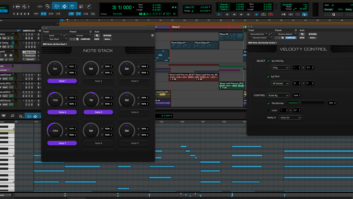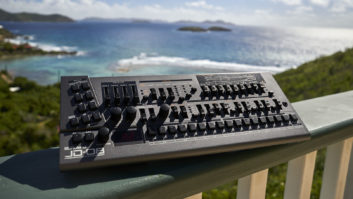When I first ventured into the realm of recording and production, I began with the Roland VS-880EX, which I still use for live recordings. Eventually, I moved to the VS-1880 and later to the VS-2480, the unit I turn to first for projects ranging from band recordings to podcasts.
SUPERSIZE YOUR UNIT
To get the most out of your VS-2480, add a Song Vault (I archive projects to it rather than make CD backups, which can be time-consuming), Roland’s MB-24 Meter Bridge and an external VGA monitor. Also invest in a mouse and keyboard — the wireless varieties are especially useful. Many VS-2480 functions can be performed using either the unit’s control surface or mouse/keyboard equivalents. Most of my tips include mouse/keyboard commands, but you should learn several ways to perform your most common operations.
SAVE, SAVE, SAVE
You might think this goes without saying, but at one time or another, everyone has lost at least one “perfect take” because they forgot DAW recording’s Golden Rule. There are three different ways to save your work on the VS-2480. Using the mouse, click Project Menu, click Store and then click Yes. Using the keyboard, press F9 (Project Menu), arrow down to Store, press Enter and then press Enter again to confirm. From the VS-2480 console: Press and hold Shift, press Store (the left transport button) and then press Enter to confirm.
ONE BAND, MANY SONGS
If you’re working with a band that’s recording many songs during a session using the same track setup, configure patchbay routings and name tracks, set up the first song, and before recording store it! Then open it again and copy the project. Make as many copies as you need, but remember to go back and change the project names; otherwise, all will come up with the same name until you do so. Using the mouse, click Project Menu, click Project List, mark the project you want to copy, click to page 2, click F1 Copy and then click F5 OK. If you want to save to a different drive, then choose that with F4 Sel Drv before selecting F5 OK. If you had changed settings that you would like to keep in this project “template,” then you can easily transfer those settings to a new project (without audio tracks) if you turn on the “Copy Utility Prm” settings when creating a new project from the File menu. The settings from the previous project will be imported automatically.
SAVING ROUTING
Sometimes, a project has many songs, and while the band’s setup remains the same, not all tracking will be the same. Or perhaps the project will not all be done on the same day. In such cases, you should save a Routing Template. This is also a helpful feature when using the VS-2480 for live sound applications. Using the mouse, click EZ Routing Menu, click Routing View and make all your routing settings; click Routing View again and then click Save. Then choose a User Template: Click F1 Name to name your setting and then click OK. To recover a setting, use Routing View and Load.
MAKING TIME
The VS-2480 does have an internal metronome with a tempo map feature, but there are times that you may need an actual click track. First, make your metronome and tempo map settings. Then click Utility Menu; click Gen/Osc, click SW to On, click Source to Metro and click F6 Exit. Click Routing View in the Track Assign section to make the connection from Gen to the track you want to record to and then simply arm the track for recording.
UTILITY SECRETS
Like many other digital toys, pressing some odd combination of keys can yield useful results. For example, determining your VS-2480’s software version (the most current version is 2.504) is easy: Power the unit down. Then press and hold Track 1’s Channel Edit and Track Select buttons while powering the unit up. The LCD will show its software version. Press Enter to complete startup of the unit. Another slick trick: Pressing the Shift and Utility buttons at the same time will shift the mouse functioning from the LCD readout to the VGA screen. The function will change each time you do this.
PAN-O-RAMA
The VS-2480’s pan knobs normally change pan values in increments of 10. To make adjustments in single-digit increments, simply hold the Shift button down while using the pan knob. Speaking of pans, you can return any track or input fader to the default 0 dB and center panning by just pressing Clear and Ch Edit for any fader you want to restore.
GET BACK
Keyboard transport is possible on the VS-2480, yet there is no simple way to return to zero. However, you can get around this by using your locate points. First set a locate for zero and for any other spots in the project you’ll want to access. Then, using the keyboard, press F12 (Utility Menu), arrow down to Locator, press Enter, use the arrows to get to the desired Locate point and press F4 Go To.
Eric Mauriello is a New York City-based composer/producer.
READ:
Field test on the Roland VS-2480
READ:
More tips for the Roland VS-2480
For Roland’s image gallery and demo video, click here



